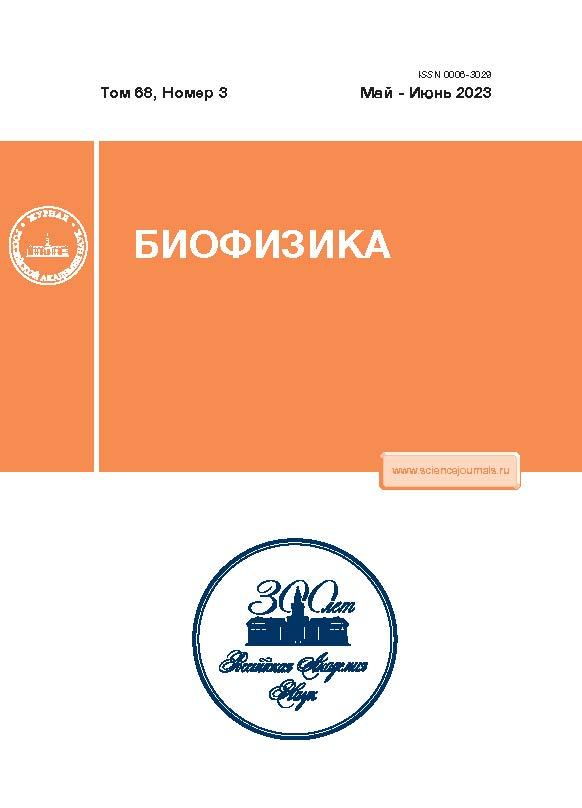Identification of pathogenic bacteria using the spectra of native DNA molecules
- Authors: Ikhlov B.L1
-
Affiliations:
- Perm State National Research University
- Issue: Vol 68, No 3 (2023)
- Pages: 489-495
- Section: Articles
- URL: https://journals.rcsi.science/0006-3029/article/view/144449
- DOI: https://doi.org/10.31857/S0006302923030092
- EDN: https://elibrary.ru/FRFWLB
- ID: 144449
Cite item
Abstract
The purpose of detecting low-frequency (relative to infrared and ultraviolet) resonance absorption of an electromagnetic field in the centimeter wavelength range using DNA molecules at a frequency corresponding to the natural frequency of torsional vibrations of the native DNA helix is to find a relationship between the length of DNA (its spectrum) and the type of a bacterium. Instead of DNA solution, cultures of different bacteria that contained DNA were used and the resonance frequencies of torsional vibrations of the helices in DNA molecules were calculated for them. The cultures were placed in test tubes or in a cuvette and were subjected to microwave irradiation. Theoretical analysis was carried out with respect to the DNA reaction to external centimeter radiation and the resonant DNA frequencies of three types of bacteria such as E. coli M17, M. avium and Mycobacterium tuberculosis were determined. Peak absorption of the ultrahigh-frequency electromagnetic field by bacterial cultures was detected at frequencies close to the calculated natural frequencies of torsional vibrations of DNA helices of the said types of bacteria: 10.271 GHz, 10.317 GHz and 10.356 GHz, respectively.
About the authors
B. L Ikhlov
Perm State National Research University
Email: boris.ichlov@gmail.com
Perm, Russia
References
- В. В. Аншелевич, А. В. Вологодский, А. В. Лукашин и М. Д. Франк-Каменецкий, Журн. эксперим. и теорет. физики, 66, 2163 (1974).
- O. A. Tiphlova and T. J. Karu, Photochem. Photobiol., 48 (1), 467 (1988).
- Г. В. Козьмин и В. И. Егорова, Биомед. технологии и радиоэлектроника, № 3, 61 (2006).
- B. M. Fischer, M. Walther, and P. Jepsen, Physics in Medicine and Biology, 47, 3807 (2002). doi: 10.1088/0031-9155/47/21/319.
- T. Globus, I. Sizov, and B. Gelmont, Adv. Biosci. Biotechnol., 4, 493 (2013) doi: 10.4236/abb.2013.43A065
- V. Garaj-Vrhovac, D. Horvat, and Z. Koren, Mutat. Res. Lett., 243 (2), 87 (1990). doi: 10.1016/0165-7992(90)90028-I
- P. Shaw, et al., Sci. Reports, 11 (1), 1 (2021). doi: 10.1038/s41598-021-93274-w
- В. Бинги, Принципы электромагнитной биофизики (Физматлит, М., 2011).
- Б. Л. Ихлов, Ф. В. Мельниченко и А. Ю. Ощепков, Вестн. новых мед. технологий, 24 (2), 141 (2017).
- Б. Л. Ихлов, А. А. Шурыгин и В. А. Дробкова, Туберкулез и болезни легких, 97 (1), 25 (2019). doi: 10.21292/2075-1230-2019-97-1-25-27
- A. A. Traves and J. M. T. Thompson, In The Mechanics of DNA, Ed. by J.M.T. Thompson (Theme Issue of Phil. Trans. Roy. Soc. A, 362 (1820), 1265) (2004).
- T. Strick, J.-F. Allemand, V. Croquette, and D. Bensimon, Progr. Biophys. Mol. Biol., 74, 115 (2000).
- Б. Л. Ихлов, Вестн. новых мед. технологий, 25 (2), 121 (2018).
- А. Н. Ковалева, И. Л. Маневич, А. А. Мусиенко и А. В. Савин, Высокомолекуляр. соединения. Сер. А, 51 (7), 1174 (2009).
- C Gabriel, E. H. Grant, R. Tata, et al., Nature, 328 (6126), 145 (1987). doi: 10.1038/328145a0
- I. J. Bigio, T. R. Gosnell, P. Mukherjee, and J. D. Safer. Biopolymers, 33 (1), 147 (1993). doi: 10.1002/bip.360330114








